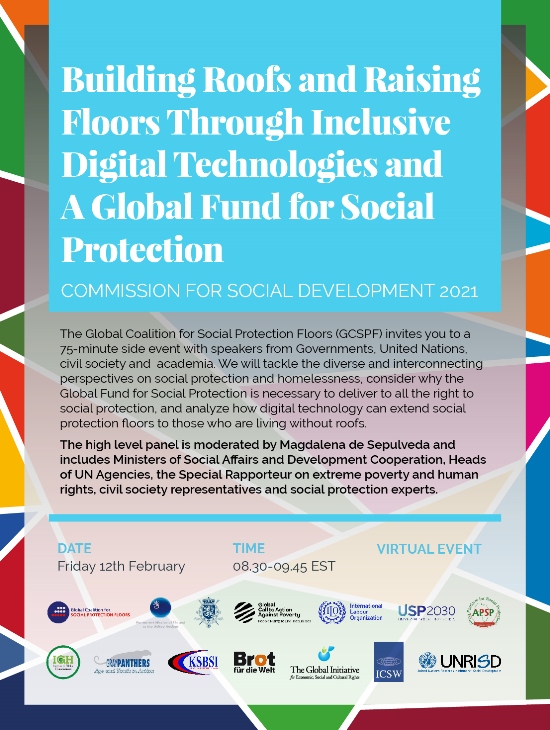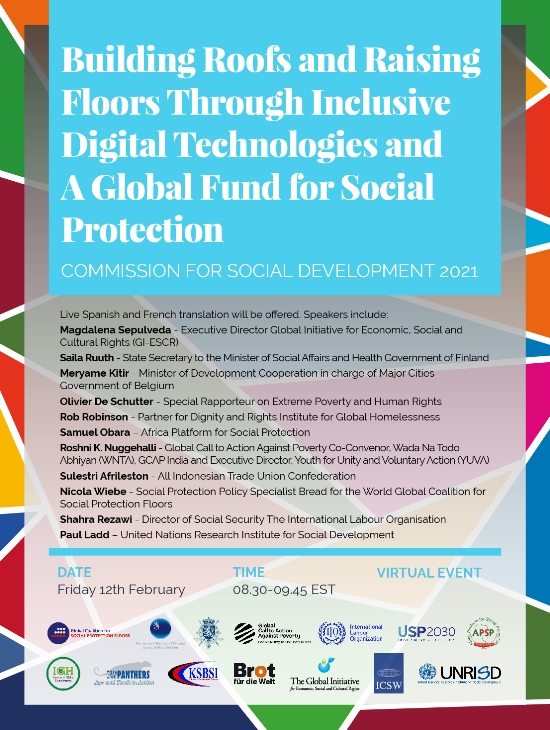The virtual side event “Building Roofs and Raising Floors Through Inclusive Digital Technologies and A Global Fund for Social Protection”, co-organized by the Global Coalition for Social Protection Floors (GCSPF) and Global Call to Action Against Poverty (GCAP) with bring together speakers from the Governments of Finland and Belgium, the United Nations, civil society, academia, and lived experience. Speakers will explore the diverse and interconnecting perspectives on social protection and homelessness, and discuss why the Global Fund for Social Protection is necessary to ensure that all have the right to social protection. Speakers will specifically consider how digital technology can extend social protection floors to those who are living without roofs.
The side event will take place at the UN Commission for Social Development 2021 (CSocD59) and will be held on Friday 12 February, 2021; 8:30 am – 9:45 am EST.
Simultaneous translation from English to Spanish and French will be available.
A secure Zoom link will be provided to all registrants. Please register at: https://depaul.zoom.us/webinar/register/WN_0IkT0ehST1m3e7bysmOQ_w
Download the Concept Note here and the flyer here.
The speaker bios are here.
Social protection is a human right, and an investment with high social and economic returns – yet more than half the world’s population do not have access to comprehensive social protection. Coverage remains particularly low for marginalized children, people with disabilities, older people, widows, women, people working in the informal economy, migrants, the LGBTQI community, and people who are experiencing homelessness.
COVID-19 has acted as an X-ray to highlight inequalities and as a stress test for access to social protection, basic human rights, income, health security, and such essential goods as housing and food. People who are homeless have been particularly vulnerable during the COVID-19 pandemic, where “staying home” has been the primary strategy for protection against the virus. Social protection is a means of ensuring those without a roof have one, as countries that have tackled homelessness are proving. Many countries are now realizing both the necessity and the long-term benefits of universal, comprehensive and adequate social protection for all, based on sustainable and equitable financing, robust, adapted and tripartite administration and anchored in law. Inclusive digital technologies can help to build roofs and raise floors for the most vulnerable among us and will ensure the sustainability of interventions.
The necessity for guaranteeing, financing and delivering social protection to all including the most hard to reach may require, notably in low income countries, the technical and financial support of a Global Fund for Social Protection, which is being explored by the UN Special Rapporteur for Extreme Poverty and the Global Coalition for Social Protection Floors. The pandemic is set to push up to 150 million people into extreme poverty1, and 150 million children into multidimensional poverty2, and we can expect that homelessness has also increased worldwide. Homelessness is one of the most visible indicators of failure in any national social protection system, and the cruelest form of social exclusion often of the most marginalized. Yale University estimates “that no less than 150 million people, or about 2 percent of the world’s population, are homeless. However, about 1.6 billion, more than 20 percent of the world’s population, may lack adequate housing.”3 A substantial number of people in the latter group (i.e. more than 20% of the global population) are likely to be permanently vulnerable to homelessness notably in times of crises. The economic impact of COVID- 19 is a driver of housing insecurity and pushing ever more people to the brink of homelessness.
To respond to the socioeconomic fallouts of the COVID-19 pandemic, many countries have put in place some social protection responses to support workers, children and families4. However, these are, for the most part, ad hoc measures of short duration, and need to be transformed into sustainable social protection measures. In relation to housing, time-limited eviction moratoriums are beginning to end around the world, putting more people at risk of homelessness.
We know that still one fifth of the world lacks guarantees to social protection and homelessness is linked to this. We know what works, and which countries have made it one of their priorities to deal with homelessness as part of their social protection systems. It is time to build on these experiences to turn short-term measures into long- term solutions for all. The COVID-19 crisis has demonstrated that countries with established social protection systems are in a much better position to address the social and economic fallout of crises faster, more effectively, and more efficiently than countries who have to introduce new schemes on an ad hoc emergency basis.
Communities that can count on inclusive data and technology systems have also been best positioned to respond to the unique needs of those who are homeless and housing insecure during the COVID-19 pandemic. It is more important than ever to make connections between social protection and the ongoing crisis in homelessness, strengthen and scale up social protection systems with digital systems, as the best way not only to cushion the impacts of the crisis on all those who are the most vulnerable, including families and those who are homeless, but to ensure an inclusive and sustainable recovery for all.
The Global Coalition for Social Protection Floors (GCSPF) and the Global Call for Action Against Poverty (GCAP) invite you to a 75-minute side event with speakers from Governments, United Nations, civil society and academia. We will tackle the diverse and interconnecting perspectives on social protection and homelessness, and consider why the Global Fund for Social Protection is necessary to deliver to all the right to social protection. We will look at how digital technology can extend social protection floors to those who are living without roofs. Examples include the sponsored use of cellphones that ensure a minimum of connectedness and a critical link to society. Insights and conclusions will be inputted into the ongoing work of the Commission of Social Development and the discussions about the Global Fund for Social Protection.
Program Outline
All are welcome. The following provisional program outline is as of 4 February 2021; an updated flier with all confirmed speakers will be circulated closer to the event.
Moderator - Magdalena Sepulveda, Executive Director of the Global Initiative for Economic, Social and Cultural Rights (GI-ESCR)
Section 1: Overview of the Topic from Member States and Special Rapporteur
Section 2: Lived Experience and Social Protections for All
Section 3: Action for change: Collaboration between civil society and the United Nations
Conclusions and recommendations
Primary Contact: Lydia Stazen, DePaul University, lstazen@ighomelessness.org
A secure Zoom link will be provided to all registrants. Please register at:https://depaul.zoom.us/webinar/register/WN_0IkT0ehST1m3e7bysmOQ_w
 |
 |
Notes:
Over 200 civil society organizations and trade unions unite to call for a Global Fund for Social Protection to protect the most vulnerable during COVID-19 and beyond.
The programme Improving Synergies Between Social Protection and Public Finance Management provides medium-term support to multiple countries aiming to strengthen their social protection systems at a national level and ensure sustainable financing. The programme aims to support countries in their efforts towards achieving universal social protection coverage.